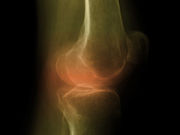Two studies test out old and new treatments for knee osteoarthritis
WEDNESDAY, Nov. 11, 2015 (HealthDay News) — Two new studies offer insight into what might — or might not — help treat knee osteoarthritis. Both studies were presented this week at the annual meeting of the American College of Rheumatology, held from Nov. 6 to 11 in San Francisco.
Tim McAlindon, M.D., M.P.H., chief of rheumatology at Tufts Medical Center in Boston, and colleagues tracked outcomes for 140 people — mainly overweight white women — with knee arthritis who averaged 58 years of age. The patients received either injections of triamcinolone hexacetonide, or placebo injections of saline, every three months for two years. While the steroid injections were deemed to be safe, they did not improve long-term outcomes of pain, mobility, or joint damage compared to the placebo.
A second, small study found that injections of ozone gas into the joint reduced pain and improved movement for people with knee osteoarthritis. The trial included 63 patients who received injections of ozone gas into the knee and a control group of 35 who received injections of air. Previous research has suggested that ozone, a naturally occurring gas, may help reduce inflammation. The patients who received the ozone gas showed significant improvements in pain, physical function, overall health, and quality of life, compared to those in the control group, the researchers said. However, there were no major differences between the two groups in the amount of time it took them to stand up, walk, return, and sit.
Researchers Carlos César Lopes de Jesus, M.D., and Virginia Fernandes Moça Trevisani, Ph.D., of Federal University of São Paulo’s Paulista School of Medicine in Brazil, believe that the ozone injections may ease pain for patients and delay the need for joint replacement surgery. However, they added that further research is needed to confirm these findings and to determine whether ozone could offer an alternative treatment.
Copyright © 2015 HealthDay. All rights reserved.








